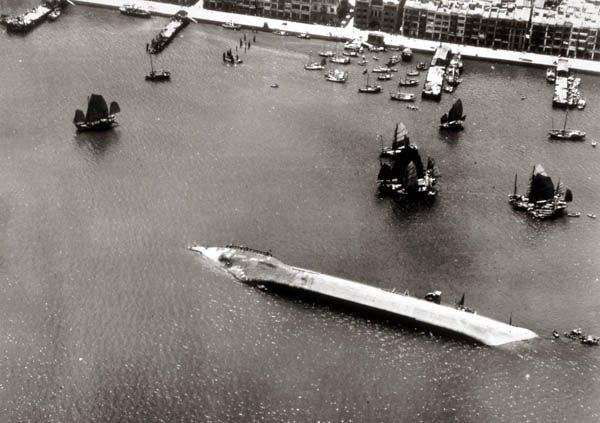When the Japanese occupied Hong Kong in December 1941, there were around 1.5 million people living in the city. The shortage of food, coal and other essential commodities had to be tackled if the Japanese were going to retain Hong Kong as an integral and useful component of its Co-prosperity Sphere. Ship building, chemical, food and match industries were highly valued by the occupying regime, although textile and clothing were the most prominent industries among the Chinese manufacturers. A total of 340 plants were engaged in textile and clothing out of 805 plants in total by late 1943.[23]
External trade, however, was cut off with the exception of trade to Free China (those areas of China not under the control of the Imperial Japanese Army). Shipping of materials and products was monopolised by the Japanese, and a number of trade agreements were signed with other Japanese-occupied territories. For example, according to one of the agreements, Hong Kong exported cotton goods, rubber articles, clothing, matches and Chinese medicines to Hainan, and in return imported salt, raw rubber, and other agricultural products.[24] Near the end of the war, food imports were predominantly beans, vegetables, flour, noodles and edible oil. Guangdong and Macao were the most frequent trading partners, although trading extended as far as Taiwan and Shanghai.[25] Overall, Hong Kong contributed around 10-15% of the total value of imports to Free China during 1942-1945.[26]
Before the Japanese occupation, the two major ferry routes plying between Hong Kong Island and Kowloon, i.e. the routes to Tsim Sha Tsui and Sham Shui Po respectively, ran more than 250 trips by 13 ferries daily. Given that most of the ferries and ships had either been sunk during the war or requisitioned by the Japanese, locally run shipping could only be resumed on a very limited scale during the initial phase following the Japanese occupation.[27] Until the end of 1942, there were just 57 vessels, of which 38 were ferries, under the control and operation of the occupying regime.[28]
In order to manage the ferry services, an office was set up under the shipping unit of the Department of Communications. A ferry service running between Central and Tsim Sha Tsui commenced on 18 January 1942, while routes from Hong Kong to Castle Peak and to Tai O began on 1 May 1942. An average of over 70,000 people a day were soon using the Tsim Sha Tsui service. To ease congestion, the original Hongkong and Yaumati Ferry Company route from Sham Shui Po to Hong Kong was resumed in late 1942. In May 1943, the Hongkong and Yaumati Ferry Company became the only private company granted permission to operate ferry services in Hong Kong waters.[29] On a regional basis, the ferry service to Macao was restarted in late January 1942. Services to locations along the Guangdong coast, like Canton Bay, Taipan, Tangjia Bay, Shiqiao and Jiangmen, were resumed soon afterwards.[30]
| Ferry routes between Hong Kong and places along Guangdong coast in early 1942 | ||
|---|---|---|
| District | No. of ship | Schedule |
| Guangdong | 3 | Daily |
| Macao | 1 | Every two days |
| Canton Bay | 3 | Twice a week |
| Taipan | 1 | Every two days |
| Tangjia Bay | 1 | Every two days |
| Shiqiao | 1 | Every three days |
| Jiangmen | 1 | Every three days |
Source: 《戦時月報に関する件》,昭和17年4月 [1942年]
Due to the shortage of essential resources, a large-scale evacuation of Hong Kong’s population was carried out in early 1942. Around 500,000 people were evacuated either on overland routes or by sea. A subsequent census taken in December 1942 recorded a total population of 1,012,707 in the Hong Kong region, representing a 30% reduction in population.[31]The first regular route for repatriation was opened on 11 January 1942. Of the vessels used, two small river vessels destined for Baoan and Shiqiao were overcrowded by 2,000 and 1,000 people respectively.[32] The resumption of steamer services to Guangzhou, Jiangmen, Macao, Canton Bay, Shantou and Shanghai sped up the evacuation. Whether travelling by sea or by land, permission had to be granted by the Japanese occupying authorities before leaving Hong Kong. All luggage was checked, and prohibited items such as religious books were confiscated. In many cases, the overcrowded steamers took two days to sail from Hong Kong via Macao to Guangzhou.[33]
Although the Japanese military regime controlled all aspects of life in Hong Kong, to a certain extent the British Administration continued to exist in the form of a shadow government in South China.[34] Among many organisations and linkages in the shadow government, the British Army Aid Group was a paramilitary organisation which contributed greatly to assisting prisoners-of-war, mostly British, to escape from Sham Shui Po Camp to China by land or sea.[35]
Notes:
- [23]《軍政下の香港:新生した大東亞の中核》(香港:香港東洋經濟社,昭和19年[1944])。
- [24]《戦時月報に関する件》(昭和17年4月[1942]);《香港占領地経済復興応急処理に関する件》(昭和17年10月[1942])。
- [25]《経済月報》(昭和19年9月分~10月分[1944])。
- [26]T. N. Chiu, The Port of Hong Kong.
- [27]香港占領地總督部報道部:《状況報告》(昭和17年4月[1942])。
- [28]《香港占領地経済復興応急処理に関する件》(昭和17年10月[1942])。
- [29]Wai Chi Sham, ‘The history of Hongkong and Yaumati Ferry Company Limited, 1923 to the 1970s’(Lingnan University, 2007), pp. 70-93.
- [30]《戦時月報に関する件》(昭和17年4月[1942])。
- [31]《總督部公報》(香港:香港佔地總督部,1942-1945)。
- [32]Robert Spencer Ward, Asia for the Asiatics?: The techniques of Japanese Occupation (Chicago: University of Chicago Press, 1945), pp. 45-50.
- [33]藍如溪、胡美林:《日治下香港的一隅》(香港:伯特利教會,2000)。
- [34]Christine Henderson, ‘The Administration of Hong Kong 1940-1945’ (University of Queensland, 1972).
- [35]Edwin Ride, British Army Aid Group: Hong Kong Resistance 1942-1945 (Hong Kong: Oxford University Press, 1981).



